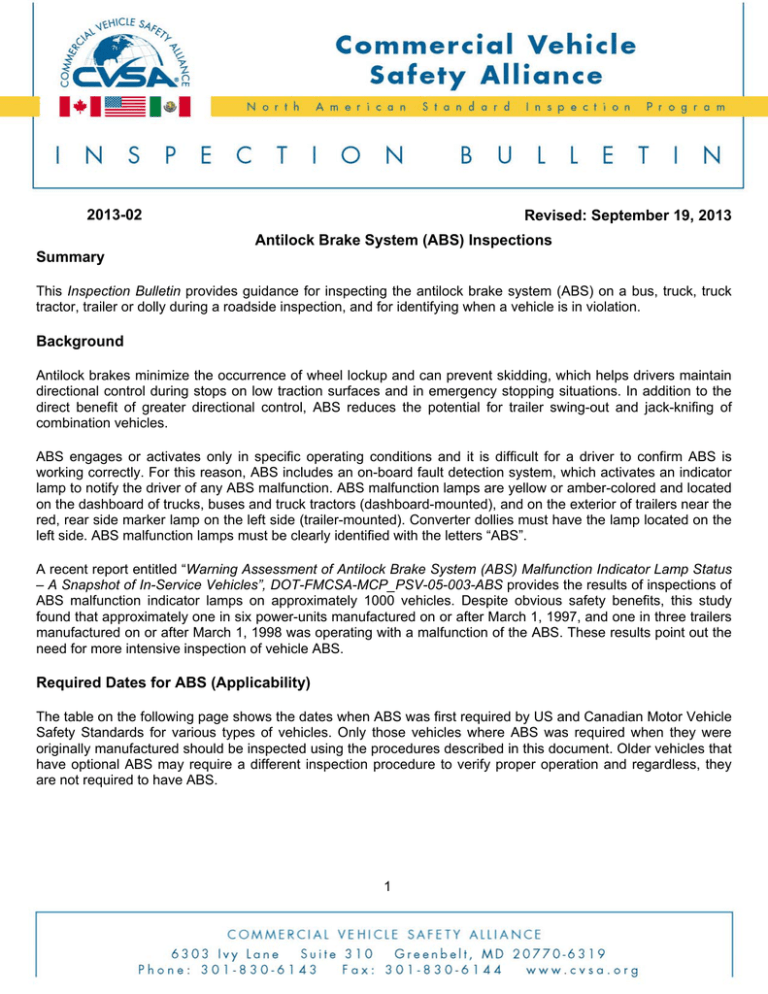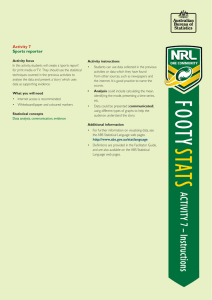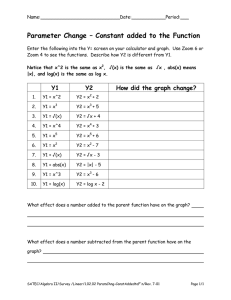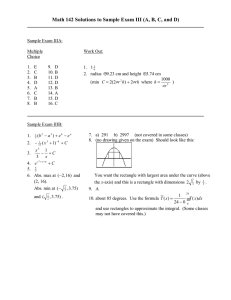
Revised: September 19, 2013
2013-02
Antilock Brake System (ABS) Inspections
Summary
This Inspection Bulletin provides guidance for inspecting the antilock brake system (ABS) on a bus, truck, truck
tractor, trailer or dolly during a roadside inspection, and for identifying when a vehicle is in violation.
Background
Antilock brakes minimize the occurrence of wheel lockup and can prevent skidding, which helps drivers maintain
directional control during stops on low traction surfaces and in emergency stopping situations. In addition to the
direct benefit of greater directional control, ABS reduces the potential for trailer swing-out and jack-knifing of
combination vehicles.
ABS engages or activates only in specific operating conditions and it is difficult for a driver to confirm ABS is
working correctly. For this reason, ABS includes an on-board fault detection system, which activates an indicator
lamp to notify the driver of any ABS malfunction. ABS malfunction lamps are yellow or amber-colored and located
on the dashboard of trucks, buses and truck tractors (dashboard-mounted), and on the exterior of trailers near the
red, rear side marker lamp on the left side (trailer-mounted). Converter dollies must have the lamp located on the
left side. ABS malfunction lamps must be clearly identified with the letters “ABS”.
A recent report entitled “Warning Assessment of Antilock Brake System (ABS) Malfunction Indicator Lamp Status
– A Snapshot of In-Service Vehicles”, DOT-FMCSA-MCP_PSV-05-003-ABS provides the results of inspections of
ABS malfunction indicator lamps on approximately 1000 vehicles. Despite obvious safety benefits, this study
found that approximately one in six power-units manufactured on or after March 1, 1997, and one in three trailers
manufactured on or after March 1, 1998 was operating with a malfunction of the ABS. These results point out the
need for more intensive inspection of vehicle ABS.
Required Dates for ABS (Applicability)
The table on the following page shows the dates when ABS was first required by US and Canadian Motor Vehicle
Safety Standards for various types of vehicles. Only those vehicles where ABS was required when they were
originally manufactured should be inspected using the procedures described in this document. Older vehicles that
have optional ABS may require a different inspection procedure to verify proper operation and regardless, they
are not required to have ABS.
1
2013-02
September 19, 2013
Antilock Brake System (ABS) Inspections
Brake
System
Type
Air
Hydraulic
Vehicle Type
Dates of Manufacture When ABS First
Required
US
Canada
Truck Tractors
March 1, 1997
Trailers, Dollies, Trucks & Buses
March 1, 1998
Trucks & Buses*
September 1, 1999
April 1, 2000
*ABS is only required on hydraulic braked trucks & buses with GVWRs exceeding 10,000lb (4536 kg)
Vehicles Manufactured on or after March 1, 2001
Both US and Canadian Motor Vehicle Safety Standards require that all air braked trucks and tractors
manufactured on or after March 1, 2001 and that are equipped to tow air braked trailers and dollies must be
equipped with an indicator lamp, in the driver’s field of view, that can indicate the status of the ABS on the units
that they tow. This lamp is in addition to the ABS malfunction lamp required for the ABS on the power-unit itself
and the external ABS malfunction lamps mounted on the sides of trailers and dollies. The Standards further
require that trailers and dollies, manufactured on or after March 1, 2001, have the ability to communicate their
ABS status to power-units that are equipped with this trailer ABS malfunction lamp so that drivers, while operating
their vehicle in a normal seated position, can be alerted to any ABS malfunctions on the units they are towing.
Because both the power-unit and the towed units must communicate for this feature to work properly, all units in
the combination must have been manufactured with this capability.
Exempt Vehicles
Certain types of vehicles are exempt from the ABS requirements regardless of the date of manufacture:
•
•
•
•
•
Any trailer that has a width of more than 102.36 inches (2.6 m) with extendable equipment in the fully
retracted position and is equipped with two short track axles in a line across the width of the trailer
Any vehicle equipped with an axle that has a gross axle weight rating (GAWR) of 29,000 pounds
(13,154kg) or more
Any truck or bus that has a speed attainable in 2 miles (3.2 km) of not more than 33 mph (53.1 km/hr)
Any truck that has a speed attainable in 2 miles (3.2 km) of not more than 45 mph (72.3 km/hr), an
unloaded vehicle weight that is not less than 95 percent of its gross vehicle weight rating (GVWR), and no
capacity to carry occupants other than the driver and operating crew
Any trailer that has a GVWR of more than 120,000 pounds (54,432 kg) which has one or more of the
following characteristics, but which is not a container chassis trailer
o Its brake lines are designed to adapt to separation or extension of the vehicle frame, or
2
2013-02
September 19, 2013
Antilock Brake System (ABS) Inspections
Its body consists only of a platform whose primary cargo-carrying surface is not more than 40
inches (101.6 cm) above the ground in an unloaded condition, except that it may include sides that
are designed to be easily removable and a permanent front end structure
Any trailer that has an unloaded vehicle weight which is not less than 95 percent of its GVWR
Any load divider dolly
o
•
•
ABS Functional Status
The functional status of ABS is indicated by the ABS malfunction lamp. When power is initially provided to the
ABS system, the lamp momentarily turns on to confirm the lamp is working and during this time a self-test of the
ABS is automatically conducted. If and when any fault is detected during the system test or if a fault is stored in
memory because it occurred intermittently on previous occasions, the lamp stays on until the fault is corrected or
power is disrupted, otherwise the lamp turns off. A problem (and a violation) is present either when the ABS
malfunction lamp fails to turn on when power is applied to the ABS or when the lamp turns on and then stays on.
ABS Electrical Power
All towing vehicles requiring ABS, including truck tractors, trucks, trailers and dollies, must be equipped with a
circuit that provides continuous electrical power to the ABS on the units that they tow. The requirement for this
circuit became effective on the same dates that ABS became required (i.e. those shown in the table on page 2).
In the event this required circuit is not operational, the vehicle has a violation.* The stop lamp circuit in the
vehicle acts as a backup to provide power to the ABS on the towed unit(s), and a system operating on
this backup circuit is not providing continuous electrical power. This violation is evident when the ABS
malfunction lamp only activates when the brakes are applied.
*Exception: In a combination with multiple towed units where any towed unit does not require ABS, the vehicles
behind a non-ABS unit may only receive ABS power when the brakes are applied. This does not indicate a defect
in the ABS system.
Towing vehicles not requiring ABS may rely only on their stop light circuits to power the ABS on the units they
tow. In this case, the only way to inspect the ABS malfunction lamps on the units they are towing is to apply the
brakes on the power-unit in order to energize the brake light circuit throughout the combination.
Most ABS equipped power-units energize the continuous power circuit for towed vehicle ABS when the ignition
switch is turned on, however, in some applications the circuit is energized even when the ignition switch is in the
off position. Full time electrical power is installed on tractors towing trailers in operations needing full time power
to the trailer. Examples include tank haulers with overflow safety monitoring systems and DOD munitions haulers
with mandatory GPS trailer tracking. In such cases, the external ABS malfunction lamps on the towed units will
not cycle with the ignition switch (or even with the brake pedal). It will be necessary to ask the driver to disconnect
and then reconnect the 7-way electrical connector while you observe the ABS malfunction indicators located on
3
2013-02
September 19, 2013
Antilock Brake System (ABS) Inspections
the towed units. When performing this procedure the trailer ABS malfunction lamp on the power-unit dashboard
may or may not cycle depending on the manufacturer of the power-unit.
ABS Malfunction Lamp Location and Identification
While the location of the ABS malfunction lamps on trailers and dollies is fairly obvious, there is considerable
variation in the location and style of dashboard-mounted ABS malfunction lamps between power-unit
manufacturers, and even among vehicles produced by any given manufacturer. There are many other indicator
lamps on the dashboard that come on and go out when the ignition switch is activated and due to the lack of
uniformity of the location and style of the ABS malfunction lamp, identifying it can be challenging, particularly
when the lamp is inoperative. In some cases, the lamp may turn on and off very quickly and may require several
cycles to correctly identify it.
If the power-unit was manufactured on or after March 1, 2001 and it is equipped to tow an air braked unit, it will
also be equipped with a trailer ABS malfunction lamp (which may not be adjacent to the power-unit’s ABS
malfunction lamp). This trailer ABS malfunction lamp may operate differently than the power-unit’s ABS
malfunction lamp depending on whether or not the power-unit is towing a unit and/or the age of the unit being
towed.
Post-Crash Inspection of ABS
The proper functionality of a vehicle’s ABS can be an important factor in many crash incidents. Persons
conducting a vehicle inspection in such cases are advised to confirm the status of the ABS using the procedures
outlined in this bulletin and are further advised to fully identify the nature of any malfunction that may be present.
Flashing ABS Malfunction Lamp
ABS may be inadvertently placed into a diagnostic mode during the inspection procedure, causing the ABS
malfunction lamp to flash repeatedly. In this case, the power to the ABS should be turned off for two minutes and
the test restarted.
[Step by Step Inspection Procedure on Next Page]
4
2013-02
September 19, 2013
Antilock Brake System (ABS) Inspections
Step by Step Inspection Procedure
Before starting the inspection, determine the date of manufacture of each of the units being inspected and if any
of the units are exempt from the ABS requirements (refer to sections above).
1.
Is the power-unit required to have ABS?
a) If yes, go to step 2.
b)If no and it is not towing any units with required ABS, no ABS inspection is required.
c) If no but it is towing any units with required ABS, go to step 7.
2. Starting with the ignition switch off, ask the driver to turn it on or start the engine while you observe the
ABS malfunction lamp for the power-unit on the power-unit’s dashboard. It must come on then, after a few
seconds, go out. Record any other response as a violation (“Power-unit’s ABS malfunction lamp fails to
come on” or “Power-unit’s ABS malfunction lamp stays on”) and continue to step 3.
3. Was the power-unit manufactured on or after March 1, 2001 and is it towing one or more units, all of which
were manufactured on or after March 1, 2001?
a) If yes to both, go to step 4.
b) If no, go to step 5.
NOTE: Disregard the trailer ABS malfunction lamp in the power-unit (i.e., skip Step 4 and go to
Step 5) if any unit in the combination was manufactured prior to March 1, 2001.
4. Starting with the ignition switch off, ask the driver to turn it on or start the engine while you observe the
ABS malfunction lamp for the trailer on the power-unit’s dashboard. It must come on then, after a few
seconds, go out. For any other outcome, refer to the table below for appropriate violation assignment. If
the lamp does not come on ask the driver to disconnect then reconnect the standard 7-way electrical cable
between the power-unit and the towed unit(s) while you observe the trailer ABS malfunction lamp on the
power-unit’s dashboard. If it still does not come on, record a violation (“Trailer ABS malfunction lamp in
power-unit fails to come on”). Go to step 6.
5
2013-02
September 19, 2013
Antilock Brake System (ABS) Inspections
Trailer ABS Malfunction Lamp in Power-Unit
Does not Come On
Comes on and Stays On with Towed Unit(s) ABS
Malfunction Lamp Illuminated
Comes on and Stays On with No Towed Unit(s)
ABS Malfunction Lamp Illuminated
Record Violation
On the Power-Unit – “Trailer ABS
malfunction lamp in power-unit fails to
come on”
On the Towed unit(s) with
illuminated lamp(s) – “Towed
unit ABS malfunction lamp stays
on”
On the Power-Unit – ”Trailer ABS
malfunction lamp in power-unit stays
on”
5. Is the power-unit towing any units with required ABS? (Refer to table on page 2)
a) If yes, go to step 6.
b) If no, stop, ABS inspection is complete.
6. Starting with the ignition switch off, ask the driver to turn it on or start the engine while you observe the
ABS malfunction indicator lamps on each towed unit with required ABS.
a) If the ABS malfunction lamps on all towed units with required ABS come on and then after a few
seconds go out, stop. ABS inspection is complete.
b) If the ABS malfunction lamp on any towed unit with required ABS comes on and stays on (or is
already on), record the violation for that unit (“ABS malfunction lamp stays on”). If the condition in
step “C” below applies, continue, if not, stop. ABS inspection is complete.
c) If the ABS malfunction lamp on any towed unit with required ABS does not come on, go to step 7.
7. Starting with the ignition switch off, ask the driver to turn on the ignition switch or start the engine and then
fully apply the service brake pedal and hold it while you observe the operation of the ABS malfunction
lamps on each towed unit with required ABS.
a) If the power-unit has required ABS and any of the ABS malfunction lamps on the towed units
(except those units towed by other units without ABS) illuminate (come on and go out or stay on)
when the brake is applied and held, record a violation on the power-unit (“continuous electrical
power circuit for towed vehicle(s) ABS not functional”).
b) If the power-unit is not equipped with required ABS and ABS malfunction lamps on all towed units
with required ABS come on and then after a few seconds go out before the brake is released,
stop. ABS inspection is complete.
c) If the power-unit is not equipped with required ABS and the ABS malfunction lamp on any towed
6
2013-02
September 19, 2013
Antilock Brake System (ABS) Inspections
unit with required ABS comes on and stays on while the brake pedal is applied, record a violation
for that unit (“ABS malfunction lamp stays on”). If the condition in step “d.” below applies, continue,
if not, stop. ABS inspection is complete.
d) If the ABS malfunction lamp on any towed unit with required ABS does not come on, go to step 8.
8. Ask the driver to disconnect then reconnect the standard 7-way electrical cable between the power-unit
and the towed unit(s) while you observe the ABS malfunction lamps on the towed units with required
ABS.
a) If the ABS malfunction lamps on all the towed units come on and then after a few seconds go out
when the cable is reconnected, stop. ABS inspection is complete.
b) If the ABS malfunction lamp on any towed unit with required ABS does not come on, record a
violation for that unit (“ABS malfunction lamp does not come on”). Stop. ABS inspection is
complete.
Inspection Flow Charts
Inspecting the ABS on a single-unit vehicle such as a truck or bus is a relatively straight forward process, it is
simply a matter of determining the date of manufacture and then, if ABS is required, turning the ignition key and
observing the ABS malfunction lamp. Performing an ABS inspection on a vehicle combination can be much more
challenging due to the different ages of the units making up the combination, the requirements for communication
between the various ABS equipped units and the various configurations of ABS electrical power. To aid in the
inspection process with combination vehicles, two flowcharts have been prepared and included in this bulletin.
Due to manufacturing dates being different, there is a flowchart for the United States and another for Canada.
While these flowcharts aid in the ABS inspection process and can serve as field reference guides, they do not
include information on how to record and assign violations. The main body of this bulletin does provide that
information, however, and must be referred to for that purpose.
7
ABS Inspection Procedure
Canadian Field Reference
Air Brake Equipped Vehicles
Performing ABS inspections, whether on a single unit or combination vehicle, requires determining applicability of regulations using the date(s) of
vehicle manufacture, powering the ABS system off and on and confirming whether the ABS malfunction lamps show violations. Additional steps are
included for inspection of vehicles requiring ABS that are in combination with vehicles not requiring ABS as well as trailers towed by power units that
provide full time power to trailers. The flowchart below summarizes the regulatory applicability, including effective dates, and the procedures for
inspecting ABS on all vehicles and combinations in Canada. When required ABS malfunction lamps do not function or remain on, please
refer to the Antilock Brake System (ABS) Inspection Bulletin for additional information on how to record and assign violations.
START HERE
Is truck, bus or trucktractor manufactured
before April 1,
2000?
Is trailer/dolly
manufactured
before April 1,
2000?
No ABS required
on power unit
(continue for towed
units).
YES
NO
Trailer mounted ABS malfunction lamp must cycle (on then off) when power is
applied. Have driver apply service brake and hold. If trailer light doesn't
cycle, disconnect and reconnect electrical power to trailer (this ensures ABS
circuit is interrupted for trailers receiving full time power).
ABS malfunction lamp on trailer must cycle when power is restored.
CONTINUE FOR TOWED UNITS
YES
NO
Is trailer/dolly
manufactured before
April 1, 2000?
YES
NO
No ABS required
on trailer/dolly.
*See Note
NO
Is trailer/dolly
manufactured
before March 1,
2001?
No ABS required
on towed unit.
*See Note
NO
ABS malfunction lamp
on dash must cycle
(on then off) when
key is turned on.
Is power unit
manufactured
before March 1,
2001?
YES
YES
YES
Is trailer/dolly
manufactured before
April 1, 2000?
NO
Trailer mounted ABS malfunction lamp
must cycle (on then off) when power is
applied. If trailer ABS malfunction lamp
doesn't cycle with the key on, disconnect
and reconnect electrical power to trailer
(this ensures ABS circuit is interrupted for
trailers receiving full time power). ABS
malfunction lamp on trailer must cycle
when power is restored.
Dash mounted trailer ABS malfunction lamp and trailer mounted ABS malfunction lamp must both cycle (on then off) when the ignition
key is turned on. If the trailer mounted ABS malfunction lamp doesn't cycle, disconnect and reconnect electrical power to trailer (this
ensures ABS circuit is interrupted for trailers receiving full time power). Trailer mounted ABS malfunction lamp must cycle when power
is restored. Dash mounted trailer ABS malfunction lamp may or may not cycle depending on the vehicle manufacturer.
*NOTE: If multiple units are being towed, any unit that is required to have ABS and is towed behind a vehicle manufactured before April 1, 2000, or a
vehicle exempt from ABS requirements must have functional ABS (unit ABS malfunction lamp cycles on then off ) upon service brake application.
Commercial Vehicle Safety Alliance
6303 Ivy Lane, Suite 310, Greenbelt, MD 20770
Phone: 301-830-6143 • www.cvsa.org
Promoting Commercial Motor Vehicle Safety and Security
Rev. January 2015
© 2015 Commercial Vehicle Safety Alliance
All rights reserved.
ABS Inspection Procedure
U.S. Field Reference
Air Brake Equipped Vehicles
Performing ABS inspections, whether on a single unit or combination vehicle, requires determining applicability of regulations using the date(s) of
vehicle manufacture, powering the ABS system off and on and confirming whether the ABS malfunction lamps show violations. Additional steps are
included for inspection of vehicles requiring ABS that are in combination with vehicles not requiring ABS as well as trailers towed by power units that
provide full time power to trailers. The flowchart below summarizes the regulatory applicability, including effective dates, and the procedures for
inspecting ABS on all vehicles and combinations in the United States. When required ABS malfunction lamps do not function or remain on, please
refer to the Antilock Brake System (ABS) Inspection Bulletin for additional information on how to record and assign violations.
START HERE
Is truck-tractor
manufactured before
March 1, 1997, or
truck/bus before
March 1, 1998?
Is trailer/dolly
manufactured
before March 1,
1998?
No ABS required
on power unit
(continue for towed
units).
YES
Trailer mounted ABS malfunction lamp must cycle (on then off) when power is
applied. Have driver apply service brake and hold. If trailer light doesn't
cycle, disconnect and reconnect electrical power to trailer (this ensures ABS
circuit is interrupted for trailers receiving full time power).
ABS malfunction lamp on trailer must cycle when power is restored.
ABS malfunction lamp
on dash must cycle
(on then off) when
key is turned on.
CONTINUE FOR TOWED UNITS
YES
NO
Is trailer/dolly
manufactured before
March 1, 1998?
YES
NO
No ABS required
on trailer/dolly.
*See Note
NO
Is trailer/dolly
manufactured
before March 1,
2001?
No ABS required
on towed unit.
*See Note
NO
NO
Is power unit
manufactured
before March 1,
2001?
YES
YES
YES
Is trailer/dolly
manufactured before
March1, 1998?
NO
Trailer mounted ABS malfunction lamp
must cycle (on then off) when power is
applied. If trailer ABS malfunction lamp
doesn't cycle with the key on, disconnect
and reconnect electrical power to trailer
(this ensures ABS circuit is interrupted for
trailers receiving full time power). ABS
malfunction lamp on trailer must cycle
when power is restored.
Dash mounted trailer ABS malfunction lamp and trailer mounted ABS malfunction lamp must both cycle (on then off) when ignition
key is turned on. If the trailer mounted ABS malfunction lamp doesn't cycle, disconnect and reconnect electrical power to trailer (this
ensures ABS circuit is interrupted for trailers receiving full time power). Trailer mounted ABS malfunction lamp must cycle when power
is restored. Dash mounted trailer ABS malfunction lamp may or may not cycle depending on the vehicle manufacturer.
*NOTE: If multiple units are being towed, any unit that is required to have ABS and is towed behind a vehicle manufactured before March 1, 1998, or a
vehicle exempt from ABS requirements must have functional ABS (unit ABS malfunction lamp cycles on then off ) upon service brake application.
Commercial Vehicle Safety Alliance
6303 Ivy Lane, Suite 310, Greenbelt, MD 20770
Phone: 301-830-6143 • www.cvsa.org
Promoting Commercial Motor Vehicle Safety and Security
© 2015 Commercial Vehicle Safety Alliance
Rev. January 2015
All rights reserved.






